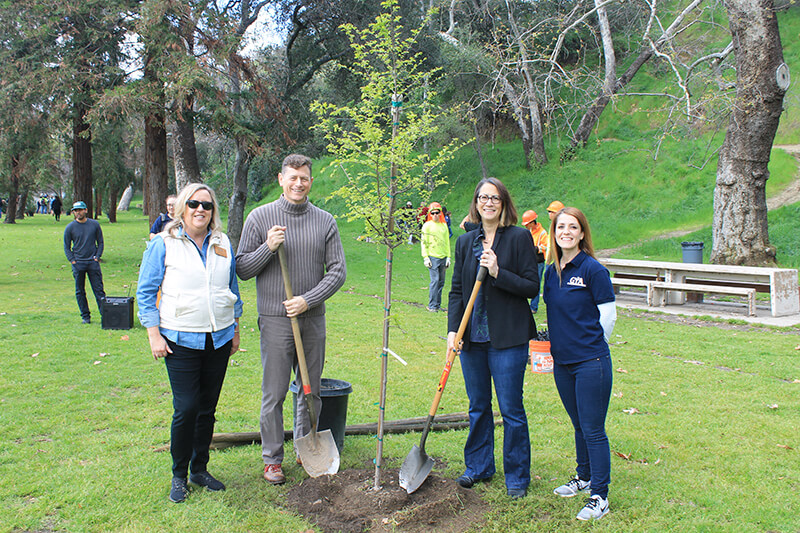Regional Newsletters Archives – August 2019
Statewide Update
CEO Report
This month we introduce the CEO Report directly from Brian Kelly. The purpose of this monthly CEO Report is to keep the Board and the public apprised of important events and milestones related to the high-speed rail program. Although there is no Board meeting in August, CEO Kelly wants to inform Board members of recent progress on a number of important fronts.
Check out the CEO Report to read about several significant developments over the last month that CEO Kelly believes will have a positive impact on our progress going forward.
Authority Receives Important Federal Approval for Environmental Reviews
In a major step forward on the nation’s first high-speed rail system, the California High-Speed Rail Authority (Authority) announced on July 25 that the State of California has received approval from the Federal Railroad Administration (FRA) to assume its federal environmental review responsibilities under the National Environmental Policy Act (NEPA) and other federal environmental laws. Requested by the Authority in January of 2018, the approval, known as NEPA assignment, enables the Authority to streamline completion of environmental approvals for the entire first phase of the program from San Francisco/Merced to Los Angeles/Anaheim. NEPA assignment further allows the Authority to meet federal construction and grant commitments while maintaining the same level of rigorous review with multiple opportunities for public input and engagement.
Authority and Kings County Reach Important Agreements
Earlier this month, the Authority and Kings County Board of Supervisors announced that they have signed three major agreements that will clear the way for substantial progress on California’s high-speed rail program in Kings County in the Central Valley. This settlement signals a positive path forward toward continued construction in Kings County and re-establishes the Authority’s relationship with the County. The agreement enables the Authority to
deliver electrified, clean high-speed rail in the Central Valley.
Comprehensive Outreach Continues in Northern California
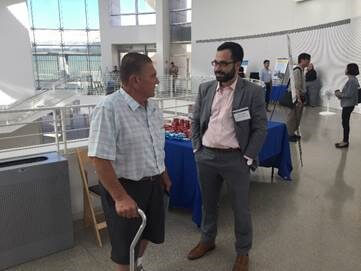
Having released staff recommendations for the State’s Preferred Alternatives for the high-speed rail routes in Northern California, the Authority began a comprehensive outreach campaign to gather valuable feedback from the public throughout the summer. The Authority Board of Directors will consider making their decisions in September as major events included several community working group meetings in July, and six public open houses in August. For more information, visit the San Francisco to San Jose Project Section page and San Jose to Merced Project Section page.
Authority Launches New User-Friendly Website

The Authority has rolled out a new, more modern website with an improved look and feel. On June 28, the Authority launched a new and improved website as part of the statewide mandate that all State of California public websites comply with American with Disability Act (ADA) standards, thus ensuring that all current, new and ongoing content is compliant with Assembly Bill 434.
The Authority had been working on launching a more modern website in addition to the ADA compliant changes. The updated website features a new look and feel, reorganizes content for improved navigation and is mobile friendly. Additional features include:
- A responsive design that will support multi-device, multi-platform, multi-browser display
- Navigation reorganization logically grouped by content themes
- Web accessibility compliance providing access to disabled users and improved usability for all visitors
- Content review, archiving and/or deletion of older, outdated information
- Improved transparency and accountability of program materials
The Authority followed all existing state laws and federal requirements in removing non-ADA compliant content from the old website. Many removed documents now have the name of the document on the previous site listed on the new website. Those documents can still be requested via the Public Records Act (PRA) request process.
Northern California Regional Update
August 2019
Northern California Firm Profiled in Authority Small Business Newsletter
In March 2014, Seth Danquah knew of the many challenges that lay ahead when he decided to launch his own small business – Danquah Group, LLC. This Pleasanton-based company is now lending its expertise to the California High-Speed Rail Project, where the firm is conducting project and construction management for Wong Harris, a prime contractor working on CP1 in the Central Valley.
Seth Danquah’s journey is one of the companies profiled in the latest edition of the Authority’s Small Business Newsletter, out now.
Salesforce Transit Center and Park Reopens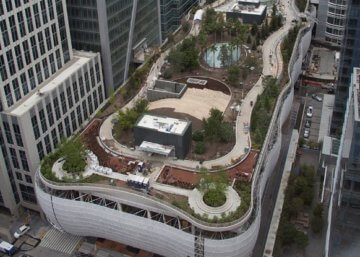
Nine months after its impressive debut, the Transbay Joint Powers Authority (TJPA) reopened the Salesforce Transit Center and public rooftop park on July 1after completing repairs on two cracked beams that support the bus deck. Muni and Golden Gate Transit have resumed bus service from the street level bus plaza and AC Transit has resumed service on the bus deck level. Salesforce Park, the Grand Hall, food trucks and public art installations have also reopened.
The transit center was temporarily closed last September as a precaution after fissures were found in two beams on the third level Bus Deck at Fremont Street. Since then, the TJPA has determined the cause of the fissures, repaired and reinforced the area and conducted an exhaustive review of the facility. They have completed a facility-wide fire and life safety reinspection program with city and state oversight and recommissioned the entire facility. After an eight-month independent peer review, the MTC’s panel concluded that the issue was localized to the Fremont Street location and the transit center may now reopen to the public.
“We are pleased to welcome the public back to the transit center and sincerely apologize for the inconvenience this temporary closure has caused,” said Mohammed Nuru, Chair of the TJPA Board of Directors. “We can now reopen this critical piece of our transportation network and important source of open space to commuters, the neighborhood and the entire region.”
At more than one million square feet, the four-block center includes a 5.4-acre rooftop public park with free activities, a public art program, shopping and dining. The transit center will ultimately serve as the northern terminus for high-speed rail when the connection to the existing rail corridor is constructed.
Caltrain’s Long-Range Vision Comes into View with New Business Plan
Caltrain, the seventh-largest commuter railroad in the country, released its draft Service Vision for the next 20-plus years of service on the line. During a recent live YouTube Town Hall event, Caltrain staff highlighted the improvements in service, capacity and connectivity that the plan entails. The draft Caltrain Business Plan 2040 Service Vision aims to ensure that Caltrain can continue to provide the greatest value possible to its riders and the Bay Area well into the future.
VTA Board Approves 2019 New Transit Service Plan
The Santa Clara Valley Transportation Authority (VTA) is developing a new transit service plan that will be implemented when BART service to Santa Clara County begins in fall 2019. In 2017, VTA adopted the Next Network Plan, which was a from-scratch redesign of the transit network that aimed to increase ridership and improve VTA’s cost-effectiveness by expanding the network of frequent routes. To review the plan, visit newtransitplan.vta.org/final-plan-home.
Southern California Regional Update
August 2019
Update on Transforming LA Union Station, Rosecrans/Marquardt Grade Separation
The California High-speed Authority (Authority) is investing in major Southern California rail infrastructure projects that that will accommodate future high-speed rail service in the region. Both the Rosecrans/Marquardt Avenue Grade Separation Project in the City of Santa Fe Springs and the Link Union Station (Link US) Project at Los Angeles Union Station (LAUS) are on track to deliver vastly improved passenger experiences aimed at meeting the region’s long-term transportation needs, the centerpiece of which will be clean, electrified high-speed rail.
LAUS Link US Update
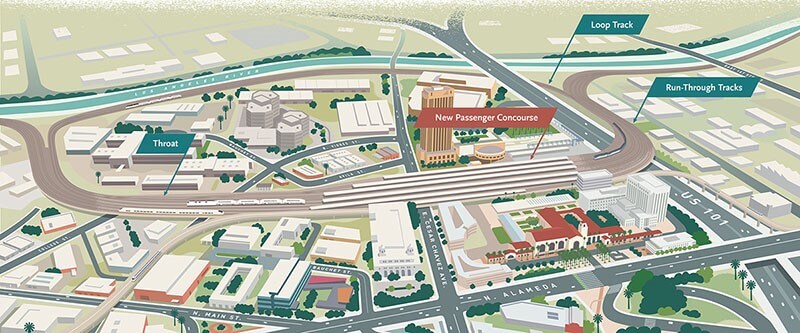
Los Angeles County Metropolitan Transportation Authority (Metro) completed the State’s environmental clearance on its Link US project in July. Designed to meet long-term regional rail needs at LAUS, Link US will now be implemented in two phases — Phase A and Phase B, an estimated $2.5 billion investment. Metro is developing the 35% preliminary engineering design for Phase A of the project totaling approximately $950 million. This phase includes two new run-through tracks on a new viaduct that will accommodate up to nine run-through tracks over Highway 101. This also includes right-of-way acquisition, utility relocation and street improvements, and active transportation improvements. Metrolink, in collaboration with Metro, is working on final design for signal and communication improvements in LAUS as part of Link US Phase A.
While Phase A of the Link US project is funded and will enhance transit connectivity in the Southern California region, Phase B is the full build-out of the Link US project to significantly increase rail service capacity at LAUS by up to 60% to accommodate the planned growth of commuter and inter-city rail services along with the future California high-speed rail service.
In 2017, the Authority’s Board of Directors approved up to $18 million to help fund engineering and technical studies and to environmentally clear a range of investments to help modernize and integrate high-speed rail at LAUS. The Authority plans to build on the successes to date and will continue to work with our regional partners to direct the remaining $423 million Southern California MOU funds to the Link US Project.
Rosecrans/Marquardt Grade Separation Update
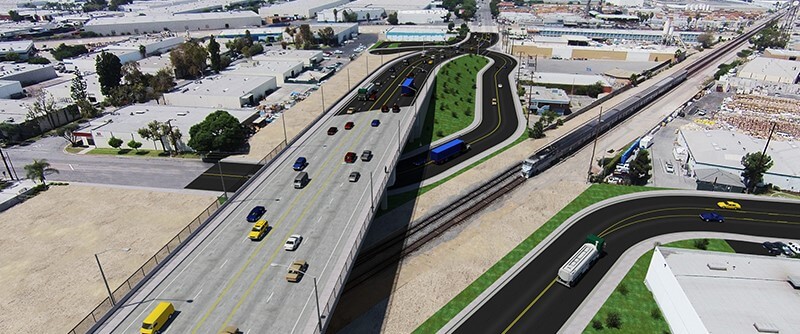
Located in the City of Santa Fe Springs, the Rosecrans/Marquardt Grade Separation Project will vastly improve the safety and traffic flow of the intersection, a grade crossing traversed by more than 112 freight and passenger trains, and 45,000 vehicles in a 24-hour period. With such heavy through traffic, this intersection has been identified by the California Public Utilities Commission as one of the most hazardous grade crossing in the state. Providing a grade separation will significantly boost safety, eliminate delays and improve the environment.
The Rosecrans/Marquardt Grade Separation project design will approach a 90% level of completion by this fall. In parallel, the right-of-way acquisition process continues and all property acquisitions for this project are on schedule for completion by summer 2020. Metro will begin early demolition in November 2019 to accommodate Southern California Edison’s work of relocating two 110-foot steel power poles, which is expected to be completed by summer 2020. The project’s environmental assessment report was approved in May 2018 and a separate Finding of No Significant Impact report was approved in November 2018 which allowed for Metro to complete the National Environmental Policy Act clearance for this project. In May of 2018, the Authority and Metro announced the approval of a joint funding agreement that allocates $76.7 million in Proposition 1A bond funds toward the project. This contribution will be matched by other local funding sources to complete the $155.3 million project.
Watch the Authority’s video about the Rosecrans-Marquardt Grade Separation Project.
Anaheim-based tree maintenance company strengthens communities — one tree at a time
From October 2018 to the end of planting season in May, West Coast Arborists, Inc. arborists and volunteers hosted 21 tree planting events or workshops in primarily low-income and disadvantaged California communities near the future high-speed rail alignment.
Yes, in My Backyard: Plant a Tree this fall
Take green action! A residential tree planting program — in coordination with the California Urban Forests Council and the cities of Buena Park, Duarte, West Covina, Hawaiian Gardens, Alhambra, Anaheim and Santa Ana — is planned for the fall. Residents can sign up at the online portal, Community Canopy, for a tree to be planted on their property.
Sponsored by the California High-Speed Rail Authority’s Urban Forestry Program, benefiting all Californians for future generations to come, the program is administered through the California Department of Forestry and Fire Protection for Urban Forestry Services (CAL FIRE) to deliver carbon sequestering trees that improve air quality. More than 1,100 trees have been planted in public places by Southern California residents in eight cities since early spring 2019 with the program continuing again this Fall toward the goal of planting 4,000 trees across the state.
Quarterly Newsletter Archive
- Winter 2024 All Aboard Newsletter
- Fall 2023 All Aboard Newsletter
- Summer 2023 All Aboard Newsletter
- Spring 2023 All Aboard Newsletter
- Winter 2023 Quarterly Newsletter
- Fall 2022 Quarterly Newsletter
- Summer 2022 Quarterly Newsletter
- Spring 2022 Quarterly Newsletter
- Winter 2022 Quarterly Newsletter
- Fall 2021 Quarterly Newsletter
- Summer 2021 Quarterly Newsletter
- Regional Newsletter - May 2021
- Regional Newsletter - February 2021
- Regional Newsletter - November 2020
- Regional Newsletter - August 2020
- Regional Newsletter - June 2020
- Regional Newsletter - February 2020
- Regional Newsletter - November 2019
- Regional Newsletter - August 2019
- Fall 2023 All Aboard Quarterly Newsletter
- Summer 2023 All Aboard Quarterly Newsletter
- Winter 2022 Quarterly Newsletter
- Regional Newsletters – Nov 2019
- Regional Newsletters – Feb 2020
- Regional Newsletters – Aug 2020
- Regional Newsletters – June 2020
- Regional Newsletters – Aug 2019
- Winter 2024 All Aboard Quarterly Newsletter
- Spring 2023 All Aboard Quarterly Newsletter
- Winter 2023 Quarterly Newsletter
- Fall 2022 Quarterly Newsletter
- Summer 2022 Quarterly Newsletter
- Spring 2022 Quarterly Newsletter
- Fall 2021 Quarterly Newsletter
- Summer 2021 Quarterly Newsletter
- Regional Newsletters May 2021
- Regional Newsletters – Feb 2021
- Regional Newsletters – Nov 2020
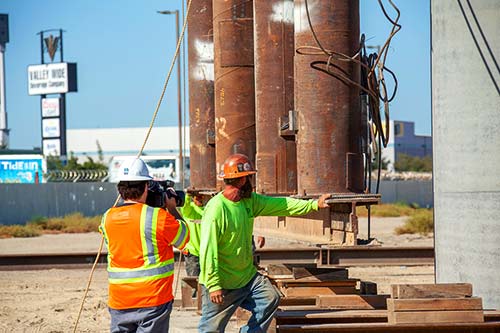
The California High-Speed Rail Authority makes every effort to ensure the website and its contents meet mandated ADA requirements as per the California State mandated Web Content Accessibility Guidelines 2.0 Level AA standard. If you are looking for a particular document not located on the California High-Speed Rail Authority website, you may make a request for the document under the Public Records Act through the Public Records Act page. If you have any questions about the website or its contents, please contact the Authority at info@hsr.ca.gov.


